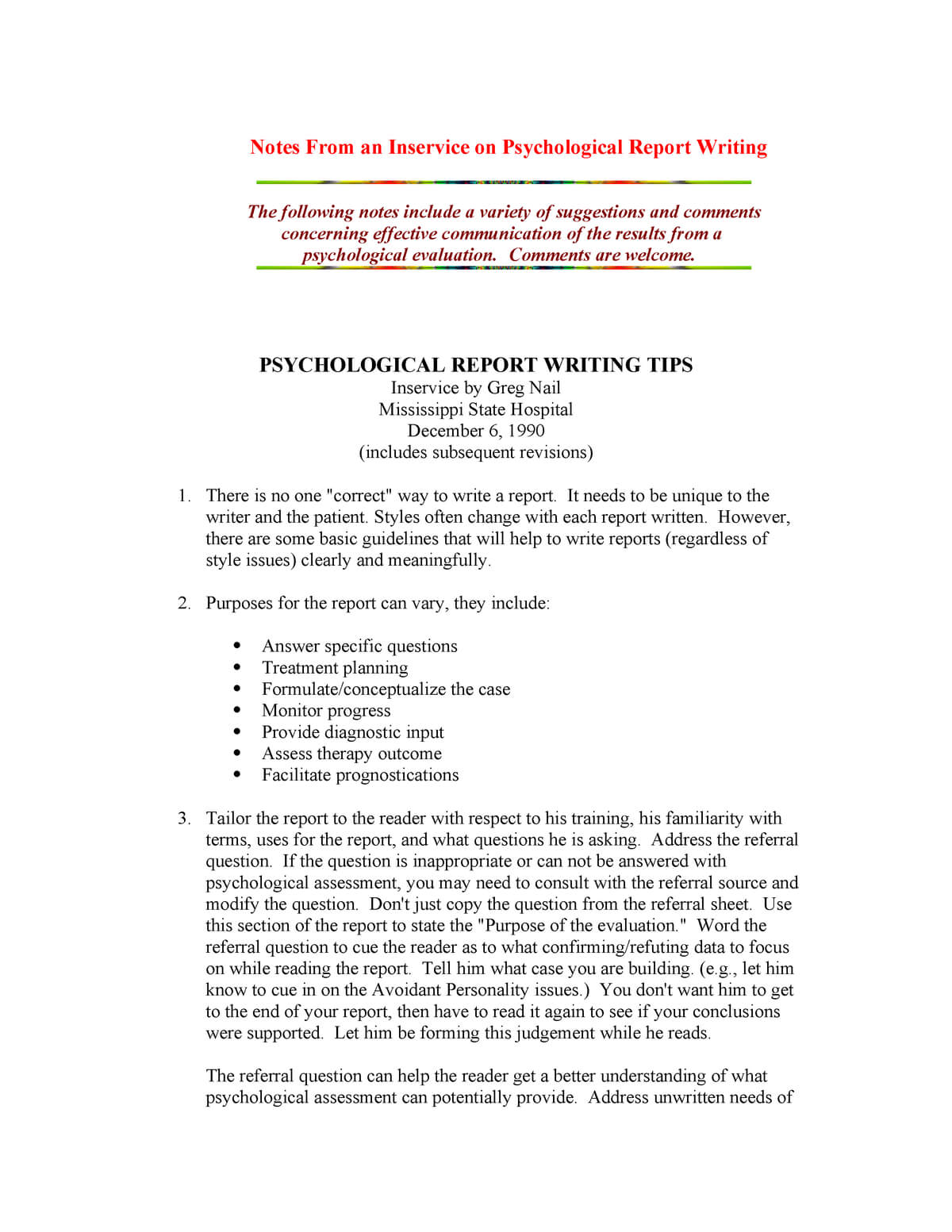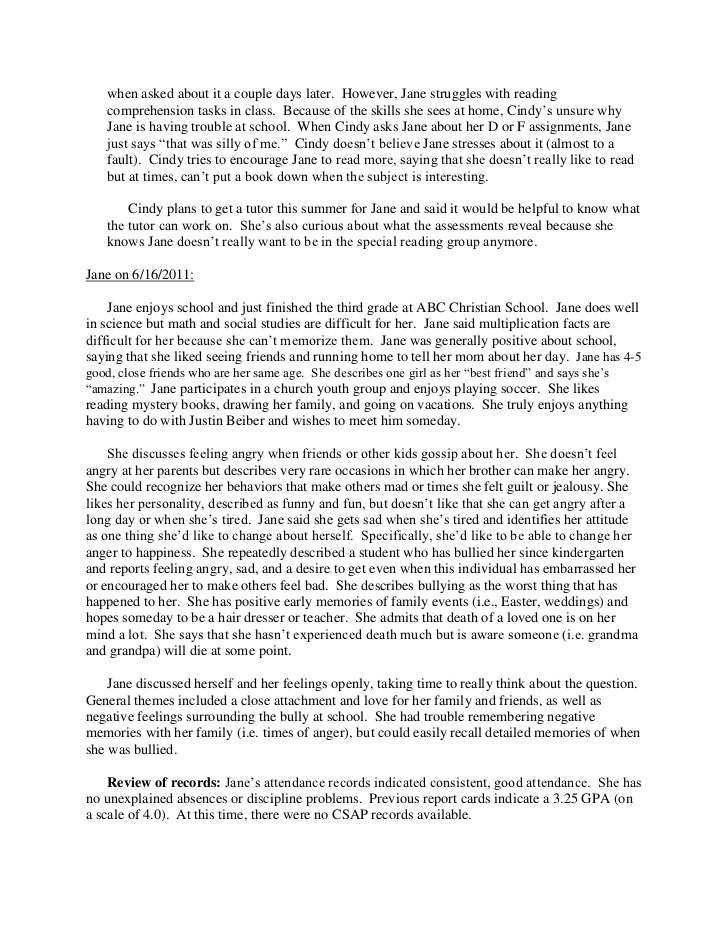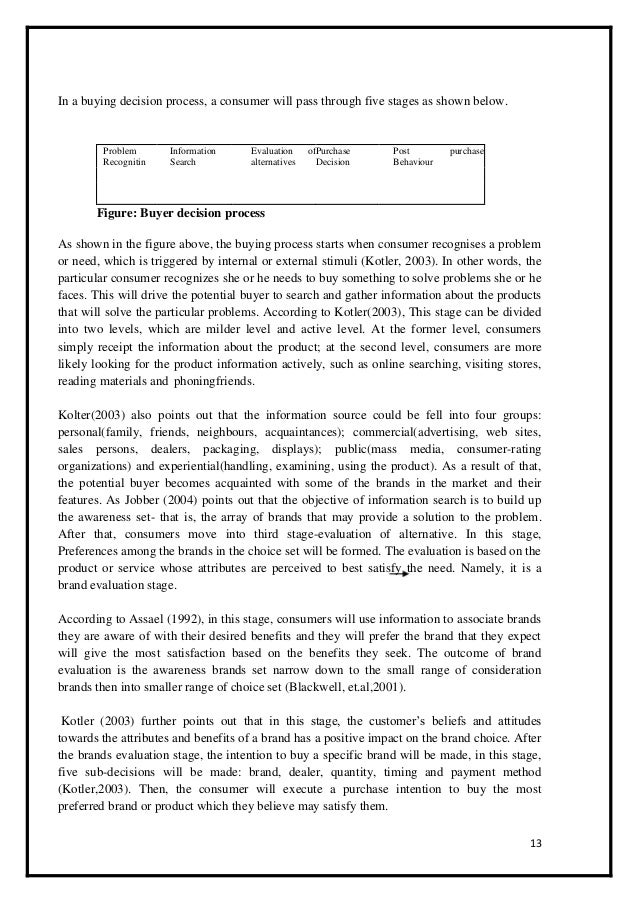
Aug 14, · Two psychologists, Dr. Robert A. Emmons of the University of California, Davis, and Dr. Michael E. McCullough of the University of Miami, have done much of the research on gratitude. In one study, they asked all participants to write a few sentences each week, focusing on particular topics Bullying is a main epidemic facing modern school kids. From stealing one’s lunch to spreading rumors on the Internet, we will explain how to write a great bullying essay to raise community’s awareness of this serious problem. To make it clear, we added 5 excellent examples of essay on bullying Mar 01, · Developing and honing psychological assessment report writing skills is not easy, says Hadas Pade, PsyD, an assistant professor at Alliant International University’s California School of Professional Psychology in San Francisco, who co-leads workshops on writing meaningful reports. Report writing is sometimes given short shrift in psychology
Steps to Writing a Bullying Essay with 5 Great Examples
Violence such as high profile report writing for school psychologists shootings can cause concern within school communities, even if they are not directly affected by the event s. Adults and students struggle to understand why these events happen and, more importantly, how they can be prevented.
School principals and superintendents can provide leadership by reassuring students, staff, and parents that schools are generally very safe places for children and youth, and reiterating what safety measures and student supports are already in place in their school. Administrators can reinforce report writing for school psychologists importance of creating a caring school community in which adults and students respect and trust each other and all students feel connected, report writing for school psychologists, understand expectations, and receive the behavioral and mental health support they need.
Messages to the community following a violent event can reassure parents and students about the safety of their schools. Here are some possible school violence prevention strategies that reinforce school safety:. Talk with students and validate their feelings. Be patient. Children and youth do not always talk about their feelings readily.
Watch for clues that they may want to talk, such report writing for school psychologists hovering around while you do the dishes or yard work. Some children prefer writing, playing music, or doing an art project as an outlet. Young children may need concrete activities such as drawing, looking at picture books, or imaginative play to help them identify and express their feelings. Be aware of signs that a student might be in distress, e.
Also be conscious of media exposure and what you say about the event. Limit television viewing be aware if the television is on in common areas. Recommended Citation: NASP School Safety and Crisis Response Committee. Responding to School Violence Prevention: Guidelines for School Administrators and Crisis Teams, report writing for school psychologists. Bethesda, MD: National Association of School Psychologists. School Violence Prevention: Brief Facts and Tips This handout addresses key considerations in preventing violence in schools.
School Violence Prevention: Tips for Parents and Educators All schools work to prevent school violence and schools are very safe places. Students, staff, and parents all have an important role in promoting school safety. School Violence Prevention: Guidelines for Administrators and Crisis Teams School Administrators and Crisis Team members can create safe, secure, and peaceful schools free from the destructive influence of violence in all of its forms.
Responding to School Violence: Tips for Administrators In This Section School Safety Drills and Exercises for Report writing for school psychologists With Autism Spectrum Disorder ASD : Tips and Resources for Educators Threat Assessment at School Bullying Prevention School Violence Prevention Recovery From Large-Scale Crises: Guidelines for Crisis Teams and Administrators Responding to a Mass Casualty Event at a School: General Guidance for the First Stage of Recovery Talking to Children About Violence: Tips for Parents and Teachers Best Practice Considerations for Schools in Active Shooter and Other Armed Assailant Drills Mitigating Psychological Effects of Lockdowns Reunification.
Issue a press release about the school district efforts to maintain safe and caring schools through clear behavioral expectations, positive behavior interventions and supports, and crisis planning report writing for school psychologists preparedness. Conduct a formal review of all school safety policies and procedures to ensure that emerging school safety issues are adequately covered in current school crisis plans and emergency response procedures. Such reviews should be conducted at least annually.
Review communication systems within the school district and with community responders. This should also address how and where parents will be informed in the event of an emergency. to review emergency response plans and to discuss any short-term needs that may be obvious in response to the current crisis.
Provide crisis training and professional development for staff based upon needs assessment. Highlight violence prevention programs and report writing for school psychologists currently being taught in school. Emphasize the efforts of the school to teach students alternatives to violence including peaceful conflict resolution and positive interpersonal relationship skills. Cite specific examples such as Second Step Violence Prevention, bully proofing, or other positive interventions and behavioral supports.
School Violence Prevention Measures to Highlight Administrators can reinforce the importance of creating a caring school community in which adults and students respect and trust each other and all students feel connected, understand expectations, and receive the behavioral and mental health support they need. Here are some possible school violence prevention strategies that reinforce school safety: Physical Safety. There is limited access to school building, including a designated entrance with all other access points locked from the exterior.
Campus monitors patrol the school parking lot noting people entering and leaving the campus. Staff members monitor and supervise areas such as hallways, cafeterias, and playgrounds.
School resource officers or security guards patrol the campus. Guests must report to main office, sign in, and wear badges; and staff report writing for school psychologists are instructed to report unfamiliar people to school office. These strategies are augmented by security systems metal detectors, video monitoring, exit door alarm systems. School-community partnerships.
A variety of school-community partnerships enhance the safety measures for our students beyond school property Block Parents, police surveillance, Community Watch programs. Crisis plans and preparedness training. Building level teams regularly review crisis and emergency plans.
All staff members participate in annual training and simulation drills, including intruder alerts, weather and fire emergencies. In addition, threat assessment and risk-assessment procedures are in place for teams. Proactive school systems. Our school provides school-wide behavioral expectations, caring school climate programs, positive interventions and supports, psychological and counseling services, and violence prevention programs such as bully-proofing, social skill development, and conflict mediation.
We promote compliance with school rules, and encourage students to report potential problems to school officials and resist peer pressure to act irresponsibly.
Participation by students. We encourage students to take responsibility for their part in maintaining safe school environments, including student participation in safety planning. They, better than adults, know the hidden or less trafficked areas of the school that are more likely to be dangerous. What to Say to Students Talk with students and validate their feelings.
Following are some suggested general key points when talking to students: Schools are safe places. Our school staff works with local police and fire departments, emergency responders, and hospitals to keep you safe. Our school is safe because…. We all play a role in the school safety. Be observant and let an adult know if you see or hear something that makes you feel uncomfortable, nervous or frightened, report writing for school psychologists.
There is a difference between reporting, tattling or gossiping. You can provide important information that may prevent harm either directly or anonymously by telling a trusted adult what you know or hear. Although there is no absolute guarantee that something bad will never happen, it is important to understand the difference between the possibility of something happening and probability that it will affect you or our school.
Senseless violence is hard for everyone to understand. Doing things that you enjoy, sticking to your normal routine, and being with friends and family help make us feel better and keep us from worrying about the event. Sometimes people do bad things that hurt others. They may be unable to handle their anger, under the influence of drugs or alcohol, or suffering from mental illness.
Adults parents, teachers, police officers, doctors, faith leaders work very hard to get those people help and keep them from hurting others. It is important for all of us to know how to get help if we feel really upset or angry and to stay away from drugs and alcohol. Stay away from guns and other weapons. Tell an adult if you know someone has a gun.
Access to guns is one of the leading risk factors for deadly violence. Violence is never a solution to personal problems. Students can be part of the positive solution by participating in anti-violence programs at school, learning conflict mediation skills, and seeking help from an adult if they or a peer is struggling with anger, depression, or other emotions they cannot control.
Contributor: Cathy Kennedy Paine, NCSP ©National Association of School Psychologists, East West Highway, SuiteBethesda, MD ;Fax ; www. Related Resources School Violence Prevention: Brief Facts and Tips This handout addresses key considerations in preventing violence in schools, report writing for school psychologists.
View All Crisis Resources, report writing for school psychologists.
FROM Cs TO SCHOOL PSYCHOLOGIST - MY ACADEMIC JOURNEY
, time: 11:39Essay Writing Service - blogger.com

Aug 14, · Two psychologists, Dr. Robert A. Emmons of the University of California, Davis, and Dr. Michael E. McCullough of the University of Miami, have done much of the research on gratitude. In one study, they asked all participants to write a few sentences each week, focusing on particular topics Professional Psychology ® (PP) is devoted to providing its readers with practical and usable blogger.com primary readership of PP is the typical practicing professional psychologist or graduate student in training to become a psychological practitioner, with a smaller secondary readership of trainers of practitioners.. PP seeks manuscripts that either describe current scientific and Physical Education, School Health and Movement Studies Description The CWU dance major provides students opportunities to develop proficiency in the knowledge, skills, and dispositions necessary for pursuing careers in dance including choreography, performance, and teaching across a

No comments:
Post a Comment